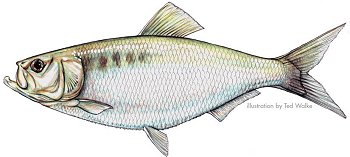
HICKORY SHAD
Alosa mediocris

Species overview: Hickory shad live in coastal marine waters and move
into fresh water to spawn. Hickory shad range from the Bay of Fundy in Maine
to the St. Johns River in Florida. The hickory shad is common from Chesapeake
Bay to North Carolina and in coastal waters of the northeast states. Between
these areas, it is scarce. In Latin, the name “mediocris” means “not
important,” or “ordinary.”
Like American shad, hickory shad are anadromous. They live in coastal ocean
waters as adults and enter brackish estuaries and swim far upstream to spawn
in freshwater rivers and creeks.
Identification: The hickory shad is silver-sided with a dark
spot on the shoulder followed in some individuals by several less distinct dark
spots. The fish are grayish green on top fading to silvery on the sides. The
sides of the head are bronze. The tip of the lower jaw, and the dorsal and caudal
fins, are darker. The tail is deeply forked with pointed lobes. The lower jaw
projects beyond the upper jaw.
The hickory shad’s shape is unique. The back curves only slightly. The
body is long but compressed. In cross section it is wedge-shaped.
The hickory shad ranges in size between the bigger American shad and the smaller
blueback herring and alewife. The most common size of a hickory shad is about
12 to 15 inches. A very large specimen would measure 24 inches long, but hickory
shad rarely reach two pounds.
Habits: In its coastal ocean enviroment, the hickory shad
feeds on squid, small fish, fish eggs and some invertebrates such as crabs and
crustaceans. It is unknown whether or not hickory shad feed when they enter
fresh water to spawn.
Life history: Very little is actually known about the hickory shad’s
life history, except that the species is anadromous. It is believed that hickory
shad enter the Delaware estuary and Delaware River, and Chesapeake Bay and the
Susquehanna River, in the spring, from April to June, to spawn. Spawning is
believed to take place at night, between dusk and around midnight, when water
temperatures reach 61 degrees. The eggs, which are buoyant and somewhat adhesive,
are easily carried downstream by swift water and current. The eggs hatch in
48 to 70 hours.